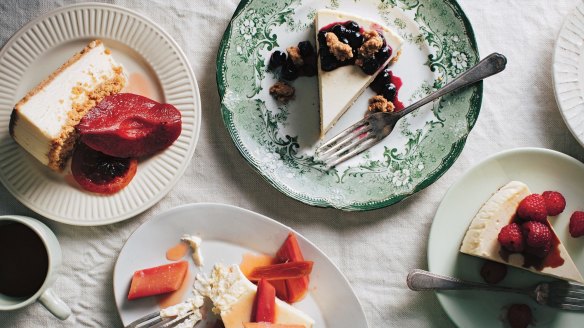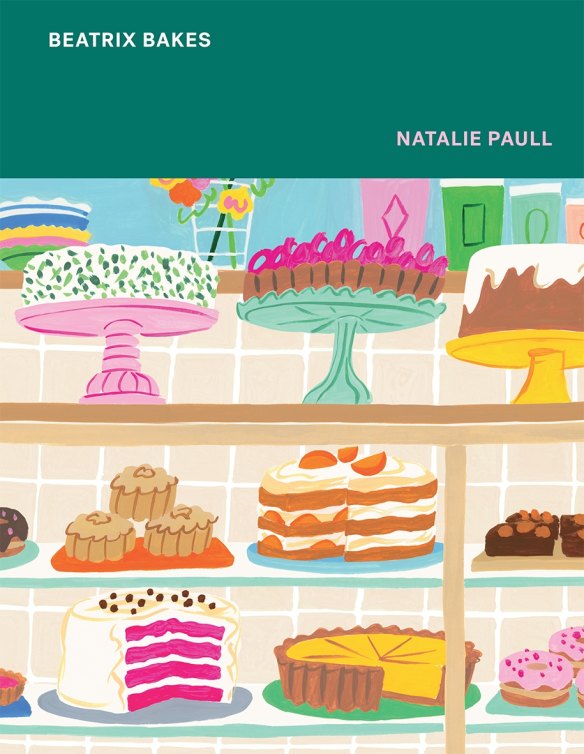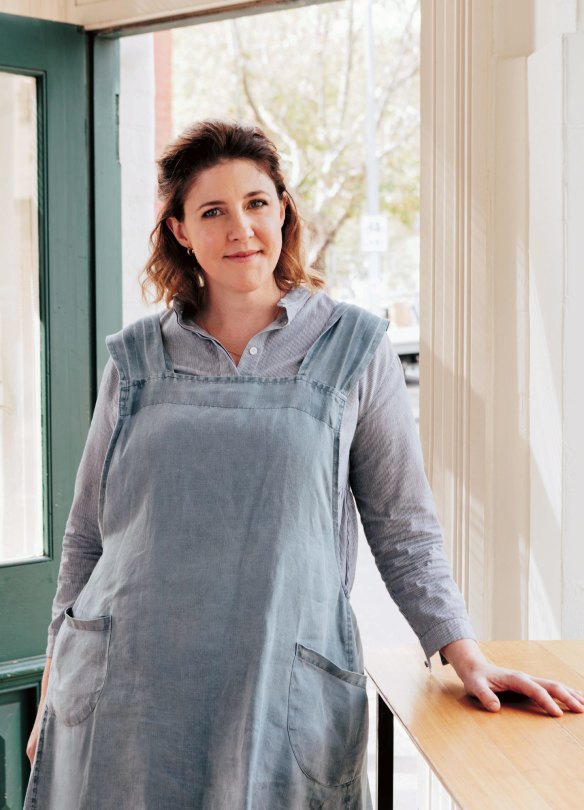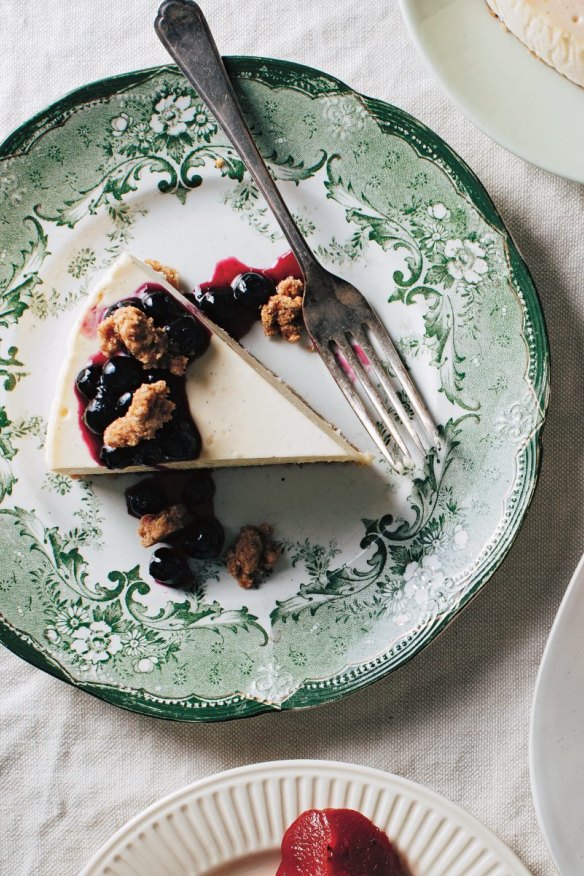The only cheesecake recipe you'll ever need

Natalie Paull of cult West Melbourne bakery-cafe Beatrix shares her beloved recipe plus topping and base variations and adaptations so you can choose your own cheesecake adventure.
My everything. The first cake I truly loved and the one to which I remain hopelessly devoted. This cheesecake is baked in a water bath, which creates the dense, ultra-creamy, silky and crack-less custard-like texture.
It is tangy, sometimes too much for those whose palates are sweet-seeking missiles. The first time you make this, I recommend you add the lemon juice to taste – just enough to get a 'that's perfect for me' feeling.
Related Article
Cheesecake caveat: if this is your first time baking a cake in a water bath, I would recommend testing the watertight qualities of your tins and trays first, especially the large roasting tray. And in smaller home ovens, the shelf can tilt precariously when you pull it out, so proceed carefully.
Beyond the baking logistics of this recipe, there lies a world of endless cheesecake possibilities at your oven door.
Start this recipe the day before so the baked cheesecake can chill to set overnight. It keeps for up to one week refrigerated, then frozen if desired; it thaws nicely.
When it is ready, it should still have a wobble to the centre – not a loose liquid wiggle but a firm undulation like a belly dancer.
'The cheesecake (that you will love the most)'
INGREDIENTS

- cooking oil spray
Crumb base
- 60g wholemeal plain flour
- 40g soft brown sugar
- ¼ tsp fine sea salt
- ½ tsp freshly ground cinnamon
- 50g unsalted butter

Cheesecake mix
- 140g castor sugar
- ¼ tsp fine sea salt
- 500g full-fat cream cheese, softened
- 100g egg (about 2 eggs), lightly beaten
- 300g/ml full-fat sour cream
- ½ tsp vanilla paste
- 40ml lemon juice
Topping
- 250g full-fat sour cream
- 10g castor sugar
- ¼ tsp vanilla paste
METHOD
- Preheat the oven to 150C. Lightly spray a baking tray with cooking oil spray and line with baking paper. Spray a 20cm round, 7.5cm deep cake tin with cooking oil spray and line the base and side with baking paper. (If you choose a tin where the base isn't welded to the side (or a springform tin), you will need to wrap the outside of the tin with a triple layer of extra-wide foil so water won't breach the tin. If you use a tin made from a single piece of metal, you won't need to do this.)
- To make the crumb base, combine the flour, brown sugar, salt and cinnamon in a wide mixing bowl. Heat the butter on the stovetop or in the microwave until just melted, then pour into the bowl. Mix together with your hands to a sticky crumble. Scatter the mix onto the prepared tray and bake for 25 minutes until evenly brown. When cool, whiz in a food processor to a fine crumb.
- Fill the base of the prepared cake tin with the crumb. Pack down the crumb lightly – the weight and moisture of the cheesecake mix will do the rest of the work. And you don't want a base you have to really crunch through when eating. Reduce the oven to 120C.
- While the base is cooking, start the cheesecake mix. Put the sugar and salt in the bowl of an electric stand mixer and stir to combine. Add the cream cheese, breaking it into chunks as you put it in the bowl. Using the paddle attachment, mix on speed 2 (above low) to slowly cream the mix, scraping down the side of the bowl often with a flexible plastic spatula. The goal is silky smooth, so just scrape and scrape and scrape so the mix is as lump free as possible. Keeping it low and slow while creaming makes a dense and creamy consistency for the cheesecake and not an airy one.
- Stay on low speed and add the eggs in two batches, scraping well between each addition, then add the sour cream and vanilla and mix until combined. Remove the bowl from the mixer and give the mix a final hand whisk to ensure there are no lumps (sorry to go on about the lumps but it's vital to the cheesecake's final beauty). Add a little of the lemon juice, then taste it before adding a little more, until you reach your tang threshold. Pour into the crumb-lined cake tin.
- For the water bath, place a piece of paper towel in the base of a high-sided roasting tin. Sit the cheesecake in the roasting tin (the paper towel will stop it from sliding around) and pour in enough hot water to come one-third up the side of the cheesecake tin. Carefully lift the tin into the oven without the water slooshing over you. Bake for about 60 minutes. When it is ready, it should still have a wobble to the centre – not a loose liquid wiggle but a firm undulation like a belly dancer. Less romantically, a thermometer inserted into the centre will read 75C.
- To make the topping, mix together the sour cream, sugar and vanilla with a plastic spatula until runny and pourable. Starting from the outside, pour the topping over the cheesecake, smoothing it gently towards the centre with an offset spatula. If you pour the topping straight onto the centre, it can break the skin on the cheesecake and fall inside. The side, being a little more cooked than the middle, will hold the topping best, so start on the side and smooth it towards the centre. If the topping behaves more like a difficult smear than a 'smoothable' flow, don't fight it. That sometimes happens when the sour cream is thick or a little warm. We can cover it with another topping later.
- Return to the oven and bake for a further 15 minutes.
- Remove the cheesecake and roasting tin from the oven and allow to cool in the water to room temperature. If you are using foil and you can see some water has breached the foil, lift the cheesecake tin out immediately and remove the foil so the base doesn't become sodden, then leave to cool to room temperature. Lightly cover with plastic wrap and refrigerate overnight until set.
- The next day, cover a flat plate or board (the base from a tart tin works well for this) with plastic wrap and place on top of the cheesecake in its tin. Flip it over confidently and place the plate on the work surface. Lift a side of the tin and gently tease out the baking paper. This will loosen the cheesecake and, with a wiggle and shake and a push on the base, it should release.* If the cheesecake is stubborn, warm the tin by either giving it a quick flash with a blowtorch or draping a hot tea towel over the tin base. This softens the butter in the crumb to aid release.
- Peel off the paper and invert again so it is top side up.**
- Serve the cheesecake chilled.
Serves 10-12
Tips:
*If the cheesecake cracks while you're removing it from the tin, push the pieces back together and chill. Cover with juicy fruit that will ooze into the fissures and hide all fractures. Bits of base that come away can be re-attached.
**If you now realise your cheesecake is very undercooked, carefully separate the filling and crumb into separate bowls. Using a small cookie cutter, stamp out circles of the base. Take some raspberries (or fruit that was destined to serve with the cheesecake) and, in pretty bowls or glasses, make messy alternating layers of the crumb, cheesecake and fruit. Finish with a fruity layer. Pots du cheesecake!
Adaptrix aka toppings and variations
Bought biscuit base
Whiz 120g of store-bought biscuits (wheaten or digestive biscuits are best) to a fine crumb in a food processor. Mix in 30g melted unsalted butter and press into the base of lined cake tin. A pinch each of freshly ground cinnamon and salt flakes added to the crumb will perk up the flavour.
Double crust cheesecake
Double the recipe for the crumb base and press half into the cake tin, then fill with the cheesecake mix. Strew the remaining crumb over the top (omit the sour cream topping), and bake for an extra 20 minutes. This version is particularly delicious with a chocolate (or chocolate chip) crumb. Imagine a giant cheesecake-like Oreo™.
Fruity bits (plus crumble?)
After the cheesecake has chilled, it can be crowned with fruit. In colder months, make a batch of butter oat streusel (recipe below), bake on a tray until golden and crumble it over the fruit.
Roasted rhubarb with ginger
Rhubarb is the sour, dynamic soulmate to cheesecake, creamy custards and buttery pastry. Oven roasting rhubarb retains the attractive stalk shape and it's less likely to explode to a pulpy mush. If it does do this (and the line is chancy between tender and pulpy), it will still be great.
Rhubarb bunches and girths aren't a standardised affair, so if your bunch is a little small, adjust the other ingredients up or down. I've given a bunch weight to help when purchasing. Colour can vary too – seek the thinner bright pink to red stalks. Green-hued rhubarb is still terrific, just lacking the va-va-voom appearance of its crimson cousins.
INGREDIENTS
- 2 small bunches rhubarb, about 400g in total
- 5cm piece of ginger
- juice of 1 orange (or other mid-acidic citrus, such as mandarin or tangelo)
- 40g castor sugar
METHOD
- Preheat the oven to 160C. Prepare the rhubarb. Remove the rhubarb leaves (the leaves are poisonous, so trim them off completely and discard), then cut the stems on a diagonal into 6cm batons. Slice in halve lengthways if the pieces are very thick. Rinse in a colander. Peel and slice the ginger into four coin-like discs.
- Have ready a generously sized non-reactive roasting tin that will hold the rhubarb in a single layer, with room around the pieces.
- Put the rhubarb batons, ginger, juice and sugar in the tin. Massage all the ingredients together with the knowledge that rhubarb does release a lot of juice when it bakes, so don't worry about the scarcity of liquid now. The amount of sugar in this recipe is my 'sour spot' but feel free to adjust to your palate. If you over-sugar, correct with a squeeze of lemon at the end. If you under-sugar, add some while the rhubarb is still hot. The sugar will melt and further sweeten the rhubarb. Keep balance in mind – rhubarb's shot of sour is welcome in sweet baking.
- Place a sheet of baking paper over the rhubarb and then cover tightly with foil. Roast for 10-30 minutes* – the timing depending on the thickness of the stalks and the heaviness of your baking vessel. Do the first check at the 10-minute mark. To do this, carefully remove the foil and lift the paper. Steam can burn mercilessly, so allow the first rush of steam to subside. Push a piece of the rhubarb near the centre; it should yield to the lightest poke but still be holding its shape. If the rhubarb feels like it needs only a smidge longer to soften it, re-foil the tray and rest at room temperature to finish cooking. The residual heat in the roasting tin should cook it to perfect softness. If it needs a little longer in the oven, check it every 5 minutes. When the rhubarb is close to cooked, it can overcook easily.
- Remove from the oven and leave to cool with the paper on top. Pack the rhubarb into containers for later delicious uses and store in the fridge. Leave the ginger in with the rhubarb, to impart more flavour in storage. Just remember to remove the pieces before using – it is quite a shock to eat a disc of ginger.
*Tip: If you have cooked the rhubarb a little too far, you can attempt to cease the cooking by removing the foil and paper from the tin and putting it in the fridge immediately. Hopefully the lovely rhubarb shape can be saved!
Burst blueberry compote
A simple method: scorch the sugar, add the blueberries, then turn off the heat. Around half the blueberries will burst and release their purple juice while the remainder will stay intact, to add pops of texture. The caramel shards will melt as they cool, adding a toffeed sweetness. This is a kindred spirit topping for the cheesecake.

INGREDIENTS
- 40g castor sugar
- 250g fresh or frozen blueberries
- ½ lemon
METHOD
- Put the sugar in a small saucepan and place over a medium-high heat. Cook until the sugar starts liquefying and turns a medium golden colour. (If the sugar starts burning, stop there and start again before you waste the fruit. Otherwise, there is little that can stop you from a juicy blueberry future!)
- Add the blueberries and, after a minute, shake the pan until the berries on the bottom start to move again. As soon as they move freely, take the pan off the heat and grab your half lemon. Squeeze the juice over the blueberries, and stir once. Don't worry that some of the berries look untouched by the heat; they will provide a firmer texture amongst the softened juicy fruit. Any toffee will dissolve after a little time. Cool to room temperature, then chill.
Butter oat streusel
These nubbly, buttery biscuity boulders are fated to be strewn on top of fruit. Cook to golden and then crumble over a cheesecake topped with soft fruit. I love to use ground oats, as it adds an earthy tone and fragile crispness.
INGREDIENTS
- 100g old-fashioned or rolled (porridge) oats
- 120g plain flour
- 100g light muscovado (or soft brown) sugar
- 150g unsalted butter, very soft and squidgy
- ¼ tsp fine sea salt
- 1½ tsp freshly ground cinnamon
METHOD
- Whiz the oats in a food processor until super fine. Tip into a bowl and add the remaining ingredients. Rub and squeeze the butter in with your fingers until all the dry ingredients are coated in butter and the mix easily forms small buttery clumps when squeezed in your fist.* Take care not to overmix everything so much that you make an actual dough.
- Bake on a tray until golden.
*The most common mistake I see with crumble is that the butter has been under incorporated and it is buttery lumps sitting in dry flour, kind of like the start of a pastry. Easy fix – rub it in a little further. If you have gone too far and into a dough/paste territory, it's a little harder to fix, as adding more flour will disrupt the ratio of the other ingredients. You can tear pieces off and dot them over the fruit for baking. It will still be delicious, just a bit clumpier.
This is an edited extract from Beatrix Bakes by Natalie Paull published by Hardie Grant Books $45 and is available where all good books are sold. Buy now
Appears in these collections
The best recipes from Australia's leading chefs straight to your inbox.
Sign upFrom our partners
Original URL: https://www.watoday.com.au/goodfood/tips-and-advice/the-only-cheesecake-recipe-youll-ever-need-20200403-h1n4xy.html
